
Figured bass is musical notation in which numerals and symbols appear above or below a bass note. The numerals and symbols indicate intervals, chords, and non-chord tones that a musician playing piano, harpsichord, organ, or lute should play in relation to the bass note. Figured bass is closely associated with basso continuo: a historically improvised accompaniment used in almost all genres of music in the Baroque period of Classical music, though rarely in modern music. Figured bass is also known as thoroughbass.

A keyboard instrument is a musical instrument played using a keyboard, a row of levers that are pressed by the fingers. The most common of these are the piano, organ, and various electronic keyboards, including synthesizers and digital pianos. Other keyboard instruments include celestas, which are struck idiophones operated by a keyboard, and carillons, which are usually housed in bell towers or belfries of churches or municipal buildings.

In music, the organ is a keyboard instrument of one or more pipe divisions or other means for producing tones. The organs have usually two or three, up to five, manuals for playing with the hands and a pedalboard for playing with the feet. With the use of registers, several groups of pipes can be connected to one manual.
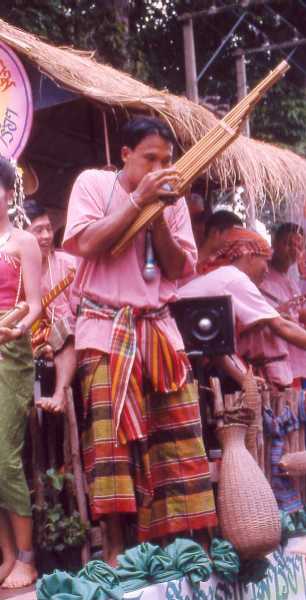
The khaen is a Lao mouth organ whose pipes, which are usually made of bamboo, are connected with a small, hollowed-out hardwood reservoir into which air is blown. The khene is the national instrument of Laos. The khene music is an integral part of Lao life that promotes family and social cohesion and it was inscribed in 2017 on the UNESCO Representative List of the Intangible Cultural Heritage of Humanity. It is used among the ethnic Lao Isan and Some tai ethnic groups such as Tai dam In north Vietnam and Lao population of the province of Stung Treng and is used in lakhon ken, a Cambodian dance drama genre that features the khene as the main instrument In Vietnam, this instrument is used among the Tai peoples and the Muong people.
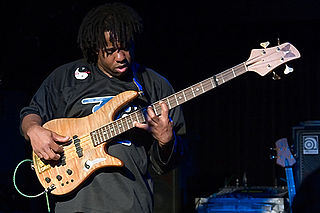
Bassline is the term used in many styles of music, such as blues, jazz, funk, dub and electronic, traditional, and classical music, for the low-pitched instrumental part or line played by a rhythm section instrument such as the electric bass, double bass, cello, tuba or keyboard.

Basso continuos parts, almost universal in the Baroque era (1600–1750), provided the harmonic structure of the music by supplying a bassline and a chord progression. The phrase is often shortened to continuo, and the instrumentalists playing the continuo part are called the continuo group.

The Music of Samoa is a complex mix of cultures and traditions, with pre- and post-European contact histories. Since American colonization, popular traditions such as rap and hip hop have been integrated into Samoan music.

A barrel organ is a French mechanical musical instrument consisting of bellows and one or more ranks of pipes housed in a case, usually of wood, and often highly decorated. The basic principle is the same as a traditional pipe organ, but rather than being played by an organist, the barrel organ is activated either by a person turning a crank, or by clockwork driven by weights or springs. The pieces of music are encoded onto wooden barrels, which are analogous to the keyboard of the traditional pipe organ. A person who plays a barrel organ is known as an organ grinder.
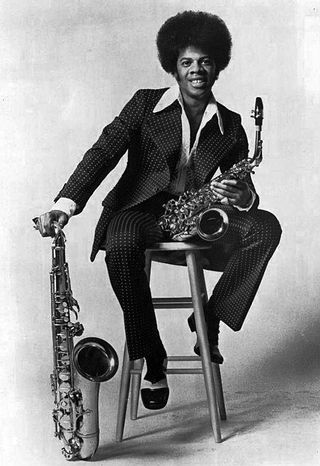
A multi-instrumentalist is a musician who plays two or more musical instruments, often but not exclusively at a professional level of proficiency.

The word "manual" is used instead of the word "keyboard" when referring to any hand-operated keyboard on a keyboard instrument that has a pedalboard, such as an organ; or when referring to one of the keyboards on an instrument that has more than one hand-operated keyboard, such as a two- or three-manual harpsichord.

Bass pedals are an electronic musical instrument with a foot-operated pedal keyboard with a range of one or more octaves. The earliest bass pedals from the 1970s consisted of a pedalboard and analog synthesizer tone generation circuitry packaged together as a unit. The bass pedals are plugged into a bass amplifier or PA system so that their sound can be heard. Since the 1990s, bass pedals are usually MIDI controllers, which have to be connected to a MIDI-compatible computer, electronic synthesizer keyboard, or synth module to produce musical tones. Some 2010s-era bass pedals have both an onboard synth module and a MIDI output.
Keyboard expression is the ability of a keyboard musical instrument to change tone or other qualities of the sound in response to velocity, pressure or other variations in how the performer depresses the keys of the musical keyboard. Expression types include:

A one-man band is a musician who plays a number of instruments simultaneously using their hands, feet, limbs, and various mechanical or electronic contraptions. One-man bands also often sing while they perform.
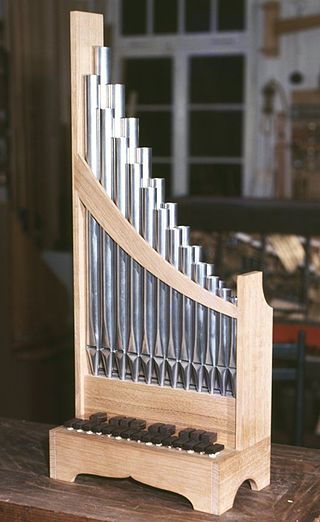
A portative organ, also known during Italian Trecento as the organetto, is a small pipe organ that consists of one rank of flue pipes, sometimes arranged in two rows, to be played while strapped to the performer at a right angle. The performer manipulates the bellows with one hand and fingers the keys with the other. The portative organ lacks a reservoir to retain a supply of wind, thus it will only produce sound while the bellows are being operated. The instrument was commonly used in European secular music from the 12th to the 16th centuries.
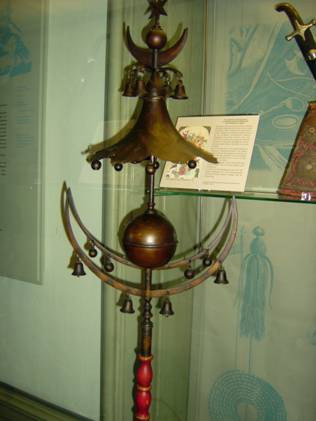
A Turkish crescent, is a percussion instrument traditionally used by military bands internationally. In some contexts it also serves as a battle trophy or object of veneration.

In music, a trio is any of the following:

A street organ played by an organ grinder is a French automatic mechanical pneumatic organ designed to be mobile enough to play its music in the street. The two most commonly seen types are the smaller German and the larger Dutch street organ.

Piano four hands is a type of piano duet involving two players playing the same piano simultaneously. A duet with the players playing separate instruments is generally referred to as a piano duo.

This is a glossary of jazz and popular music terms that are likely to be encountered in printed popular music songbooks, fake books and vocal scores, big band scores, jazz, and rock concert reviews, and album liner notes. This glossary includes terms for musical instruments, playing or singing techniques, amplifiers, effects units, sound reinforcement equipment, and recording gear and techniques which are widely used in jazz and popular music. Most of the terms are in English, but in some cases, terms from other languages are encountered.

Hurdy Gurdy is a 1929 animated short film which is presented by Carl Laemmle and was produced by Walter Lantz, who he and his wife would go on to make Woody Woodpecker. The film, which is animated by R.C. Hamilton, Bill Nolan and Tom Palmer, features Oswald the Lucky Rabbit, who is substituted for the organ grinder's dancer, after the original one is comically swallowed up by Oswald's bubblegum.



















